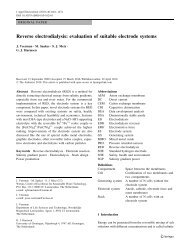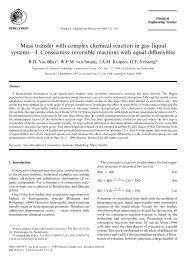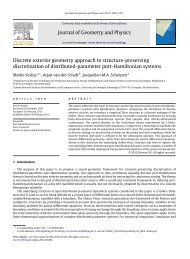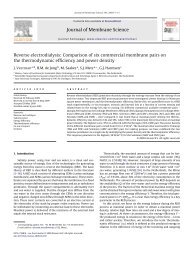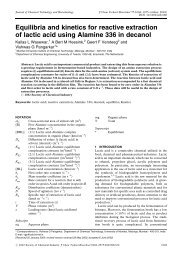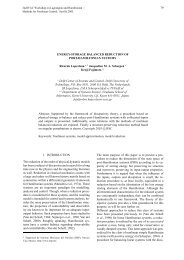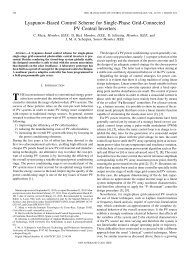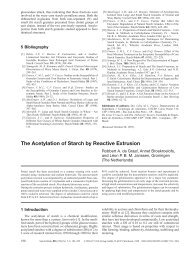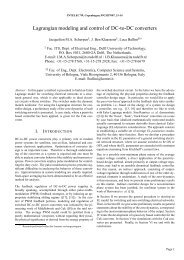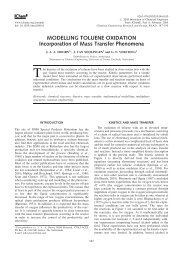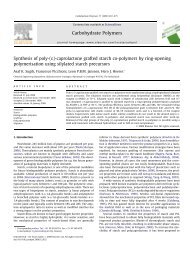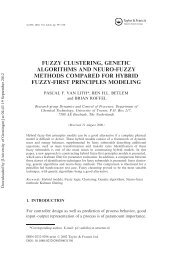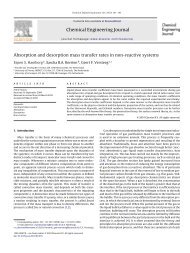Gas-Liquid Mass Transfer Coefficient in Stirred Tank Reactors - ITM
Gas-Liquid Mass Transfer Coefficient in Stirred Tank Reactors - ITM
Gas-Liquid Mass Transfer Coefficient in Stirred Tank Reactors - ITM
You also want an ePaper? Increase the reach of your titles
YUMPU automatically turns print PDFs into web optimized ePapers that Google loves.
<strong>Gas</strong>–<strong>Liquid</strong> <strong>Mass</strong> <strong>Transfer</strong> <strong>Coefficient</strong> <strong>in</strong> <strong>Stirred</strong><br />
<strong>Tank</strong> <strong>Reactors</strong><br />
Archis A. Yawalkar 1 , Albertus B.M. Hees<strong>in</strong>k 2 , Geert F. Versteeg 2 and Vishwas G.<br />
Pangarkar 1*<br />
1 Mumbai University, Institute of Chemical Technology (formerly U.D.C.T.), Matunga, Mumbai–400 019, India<br />
2 University of Twente, Faculty of Chemical Eng<strong>in</strong>eer<strong>in</strong>g, P.O. Box 217, NL-7500 AE Enschede, The Netherlands<br />
Knowledge of gas–liquid mass transfer rate and therefore volumetric<br />
gas–liquid mass transfer coefficient (k L a) is very important <strong>in</strong><br />
design<strong>in</strong>g or <strong>in</strong> the scale-up of gas–liquid stirred tank reactors<br />
(STR). In the literature k L a is correlated either by us<strong>in</strong>g dimensionless<br />
groups (Smith and Warmoeskerken, 1985; Smith, 1991) or energy <strong>in</strong>put<br />
criterion (Smith et al., 1977; van’t Riet, 1979; Hickman, 1988; Whitton and<br />
Nienow, 1993) based on Kolmogoroff’s theory. Correlations based on<br />
dimensionless groups are of the form k L a = f(Fr, Fl G , D/T, etc.) while<br />
correlations based on energy <strong>in</strong>put criterion are of the form k L a = f (P/V L ) a<br />
(V G ) b .<br />
In our earlier work (Yawalkar et al., 2002), it has been shown that gas<br />
hold-up (e G ) <strong>in</strong> STR can be reliably predicted by a correlation based on a<br />
relative dispersion parameter, N/N cd , over wide range of geometric<br />
conditions and operat<strong>in</strong>g parameters. <strong>Gas</strong> hold-up data available <strong>in</strong> the<br />
literature (Greaves and Barigou, 1990; Smith, 1991; Rewatkar et al.,<br />
1993) for larger tanks (T = 0.57 m to 2.7 m) equipped with either radial<br />
flow impeller (standard six-blade disc turb<strong>in</strong>es (DTs)) or axial flow<br />
impellers (pitched bladed turb<strong>in</strong>es (PBTs)) of different sizes and different<br />
sparger designs show unanimity with the proposed correlation.<br />
In the present work it has been shown that similar to gas hold-up (e G ),<br />
volumetric gas–liquid mass transfer coefficient (k L a) can be correlated<br />
reliably over a wide range of geometric configurations and operat<strong>in</strong>g<br />
parameters (impeller speed/power <strong>in</strong>put and gas rate) by a correlation<br />
based on the relative dispersion term N/N cd .<br />
N cd represents the m<strong>in</strong>imum impeller speed at which all the liquid <strong>in</strong> a<br />
tank is <strong>in</strong> contact with the sparged gas. Extensive studies are available on<br />
N cd <strong>in</strong> the literature (Nienow et al., 1977; Chapman et al., 1983; Rewatkar<br />
and Joshi, 1993). For any economical gas–liquid mix<strong>in</strong>g operation <strong>in</strong> STR,<br />
m<strong>in</strong>imum impeller speed for complete dispersion of the gas (N cd ) must be<br />
known, because at N cd complete dispersion of the gas <strong>in</strong> liquid phase is<br />
obta<strong>in</strong>ed (Nienow et al., 1977; Chapman et al., 1983). Also, the mix<strong>in</strong>g<br />
process at any impeller speed below N cd results <strong>in</strong> <strong>in</strong>complete dispersion<br />
of the gas. In other words, at an impeller speed below N cd , there is very<br />
little or no gas <strong>in</strong> the region below the impeller. Therefore, the lower part<br />
of the tank is wasted, result<strong>in</strong>g <strong>in</strong> poor performance of the STR.<br />
If the gassed power number (N PG ) or the ratio of power numbers<br />
under gassed conditions and ungassed condition (N PG /N Po ) versus the<br />
*Author to whom correspondence may be addressed. E-mail address:<br />
vgp@udct.ernet.<strong>in</strong><br />
Volumetric gas–liquid mass transfer coefficient (k L a)<br />
data available <strong>in</strong> the literature for larger tanks (T = 0.39 m<br />
to 2.7 m) have been analyzed on the basis of relative<br />
dispersion parameter, N/N cd . It was observed that at a<br />
given superficial gas velocity (V G ), k L a values were<br />
approximately the same irrespective of geometric<br />
configuration (size of the tank, type and size of the<br />
impellers, type of the sparger, etc.) at a particular<br />
N/N cd . A s<strong>in</strong>gle correlation based on N/N cd is<br />
presented which shows satisfactory agreement with<br />
the k L a data of different workers.<br />
Les données sur le coefficient de transfert de<br />
matière gaz–liquide volumétrique (k L a) fournies par la<br />
littérature scientifique pour des réservoirs de grande<br />
taille (T = 0,39 m à 2,7 m), ont été analysées relativement<br />
au paramètre de dispersion relative, N/N cd . On a<br />
observé qu’à une vitesse de gaz superficielle donnée<br />
(V G ), les valeurs de kLa sont approximativement les<br />
mêmes peu importe la configuration géométrique<br />
(taille du réservoir, type et taille des turb<strong>in</strong>es, type<br />
d’aérateur, etc.) pour un N/N cd donné. On présente<br />
une corrélation simple basée sur N/N cd qui montre un<br />
accord satisfaisant avec les données de k L a de<br />
différents chercheurs.<br />
Keywords: STR, k L a, N cd , relative dispersion (N/N cd ), V G .<br />
flow number (Fl G ) curve is plotted, a m<strong>in</strong>imum occurs<br />
<strong>in</strong> the gassed power number at N cd (Nienow et al.,<br />
1977; Bakker and van den Akker, 1994) (Figure 1). At<br />
N cd the grow<strong>in</strong>g gas cavity covers the whole of the<br />
rear face of the blade, which causes drop <strong>in</strong> power<br />
<strong>in</strong>put (Chapman et al., 1983). Study<strong>in</strong>g the large<br />
amount of data generated from the experimental work<br />
<strong>in</strong>corporat<strong>in</strong>g wide range of system configurations<br />
(flat/dished bottom tanks with T = 0.29 to 1.83 m,<br />
D/T = 0.125 to 0.5, C/T = 0.25 to 0.5, r<strong>in</strong>g spargers,<br />
pipe spargers and po<strong>in</strong>t spargers) and operat<strong>in</strong>g<br />
840 The Canadian Journal of Chemical Eng<strong>in</strong>eer<strong>in</strong>g, Volume 80, October 2002
Table 1. Experimental details of the works on k L a <strong>in</strong> large STR <strong>in</strong> coalesc<strong>in</strong>g (air-water) systems, studied <strong>in</strong> the present work..<br />
Researchers T, m Type of Type of D, m V G , m/s N, rev/s P/V L , W/m 3 Method employed<br />
the impeller the sparger or measurement<br />
f of k L a<br />
Smith et al. 0.61, 0.91 6DT Pipe 0.20, 0.30, 4 ¥ 10 –3 to 0.9 to 8.5 20 to 5000 Dynamic method<br />
(1977) and 1.83 0.67 and 0.91 4.6 ¥ 10 –2<br />
Calderbank (1958; 0.50 6DT Orifice 0.166 5 ¥ 10 –3 to 300-3500 Transmission<br />
van’t Riet 1979) 4 ¥ 10 –2<br />
Chandrasekharan 1.22 6DT Pipe 0.40 3.5 ¥ 10 –3 to 1.75 to 94 to 1596 Dynamic method<br />
and Calderbank 1.8 ¥ 10 –2 4.43<br />
(1981)<br />
Smith and 0.44 6DT R<strong>in</strong>g 0.175 3 ¥ 10 –3 to 3 to 9 Dynamic method<br />
Warmoeskerken 1.3 ¥ 10 –2<br />
(1985)<br />
L<strong>in</strong>ek et al. (1987) 0.29 6DT Pipe 0.095 2.12 ¥ 10 –3 4.17 to 100-3500 Dynamic method<br />
and 4.24 ¥ 10 –3 14.17<br />
Hickman (1988) 0.60 and 2 6DT 0.2 and 0.66 2 ¥ 10 –3 to 50-3500 Steady state method<br />
1.7 ¥ 10 –2<br />
Smith (1991) 0.6, 2.4 6DT 0.198, 0.33, 0.79, 5 ¥ 10 –3 to 0.36 to Dynamic method<br />
and 2.7 0.89 and 1.2 1.50 ¥ 10 –2 * 5.1*<br />
Whitton and 0.61 6DT R<strong>in</strong>g 0.20 4.7 ¥ 10 –3 to 1.42 to 210-1350 Dynamic method<br />
Nienow (1993) and 2.67 and 0.88 3.32 ¥ 10 –2 5.75<br />
Bakker and 0.44 A315 R<strong>in</strong>g 0.177 1 ¥ 10 –2 3.43 to 9.16 100-1500 Dynamic method<br />
van den Akker PBT<br />
(1994)<br />
Zhu et al. (2001) 0.39 6DT R<strong>in</strong>g 0.13 1 ¥ 10 –3 to 100-1500 Dynamic method<br />
7.5 ¥ 10 –3<br />
* This range is derived from the k L a values given <strong>in</strong> the parity plot of Smith (1991), correlation proposed by him and the range of tank diameter (T) and<br />
D/T ratio studied by Smith (1991).<br />
Figure 1. <strong>Gas</strong>sed to ungassed power number ratio (N PG /N Po ) versus<br />
gassed flow number (Fl G ) for gas–liquid STR.<br />
conditions (P/V L up to 8200 W/m 3 and V G = 0.2 to 4.6 ¥ 10 –2<br />
m/s), Nienow et al. (1977) have given a correlation for N cd <strong>in</strong><br />
an STR equipped with a standard six-blade disc turb<strong>in</strong>e (DT).<br />
The correlation proposed by Nienow et al. (1977) for DT is:<br />
( )<br />
QGT Ncd<br />
=<br />
D<br />
( ) ( )<br />
05 . 025 .<br />
4<br />
2<br />
Equation (1) is very reliable for predict<strong>in</strong>g N cd for disc<br />
turb<strong>in</strong>es (Yawalkar et al., 2002). Chapman et al. (1983) studied<br />
N cd for different impellers such as four-blade mixed flow<br />
impellers pump<strong>in</strong>g up (MFUs) and pump<strong>in</strong>g down (MFDs),<br />
six-blade MFUs and MFDs, axial flow impellers pump<strong>in</strong>g up<br />
(AFUs) and pump<strong>in</strong>g down (AFDs), disc turb<strong>in</strong>es (DTs) and<br />
angular-bladed disc turb<strong>in</strong>es (ADTs). Rewatkar and Joshi (1993)<br />
have extensively studied N cd <strong>in</strong> an STR equipped with six-blade<br />
downflow pitched turb<strong>in</strong>es. N cd can be determ<strong>in</strong>ed by simple<br />
methods such as visual observation, from the power <strong>in</strong>put<br />
curve, and from mix<strong>in</strong>g time studies (Rewatkar and Joshi,<br />
The Canadian Journal of Chemical Eng<strong>in</strong>eer<strong>in</strong>g, Volume 80, October 2002 841<br />
(1)
Table 2. Correlations proposed by different workers to estimate volumetric<br />
gas–liquid mass transfer coefficient (k L a) <strong>in</strong> STR and used <strong>in</strong> the present work.<br />
Researchers Correlation Proposed<br />
Calderbank (1958) van’t Riet k L a = 0.026 (P/V L ) 0.4 (V G ) 0.5<br />
( 1979)<br />
Smith et al. (1977) k L a = 0.01 (P/V L ) 0.475 (V G ) 0.4<br />
Smith and Warmoeskerken BLC regime:<br />
(1985) k L a = 1.1 ¥ 10 –7 (Fl G ) 0.6 (Re N ) 1.1 (N)<br />
ALC regime:<br />
k L a = 1.6 ¥ 10 –7 (Fl G ) 0.42 (Re N ) 1.02 (N)<br />
L<strong>in</strong>ek et al. (1987) k L a = 4.95 ¥ 10 –3 (P/V L ) 0.593 (V G ) 0.4<br />
Hickman (1988) For T = 0.60 m<br />
k L a = 0.043 (P/V L ) 0.4 (V G ) 0.57<br />
For T = 2 m<br />
k L a = 0.027 (P/V L ) 0.54 (V G ) 0.68<br />
Smith (1991) k L a = 1.25 ¥ 10 –4 (D/T) 2.8<br />
(Fr) 0.6 (Re N ) 0.7<br />
(Fl G ) 0.45 (D/g) –0.5<br />
Whitton and Nienow (1993) k L a = 0.57 (P/m) 0.4 (V G ) 0.55<br />
Zhu et al. (2001) k L a = 0.031 (P/V L ) 0.4 (V G ) 0.5<br />
1993). The last two are objective methods but show good<br />
agreement with the first, which is subjective (Rewatkar and<br />
Joshi, 1993).<br />
Relative <strong>Gas</strong> Dispersion (N/N cd )<br />
Turbulent fluctuations <strong>in</strong> the gas–liquid dispersion control the<br />
drag on the bubble and hence the bubble size (Calderbank<br />
et al., 1959; H<strong>in</strong>ze, 1955; Hughmark 1974; Miller, 1974). The<br />
bubbles break up when the hydrodynamic stresses (Reynolds<br />
Table 3. Hughmark’s (1980) correlation for impeller power <strong>in</strong>put<br />
under aerated condition (PG /PO ) for standard six bladed disc turb<strong>in</strong>e<br />
is based on follow<strong>in</strong>g experimental details.<br />
<strong>Tank</strong> diameter, T (m) 0.21 to 3.33<br />
D/T 0.33 to 0.576<br />
C/T 0.33 to 0.67<br />
H/T 0.75 to 1.87<br />
VG (max.) 0.053 m/s<br />
Blade width (w),m 0.2D<br />
m (mPa·s) 0.8 to 28<br />
r (kg/m3 ) 870 to 1600<br />
s (g/s2 ) 25 to 72<br />
PG /PO 0.31 to 0.8<br />
stresses) outweigh the surface tension force (H<strong>in</strong>ze, 1955;<br />
Calderbank et al., 1959; Walter and Blanch ,1986). Walter and<br />
Blanch (1986) gave the correlation of maximum stable bubble<br />
size on the assumption that bubble break-up is caused by the<br />
eddies of the same scale as the maximum stable bubble size.<br />
Parthasarathy and Ahmed (1991) have discussed the process of<br />
bubble break-up <strong>in</strong> a turbulent field us<strong>in</strong>g the criterion of power<br />
dissipation accord<strong>in</strong>g to Kolmogoroff’s theory. Accord<strong>in</strong>gly, they<br />
concluded that bubbles are broken by eddies of the <strong>in</strong>ertial subrange.<br />
The turbulence <strong>in</strong>creases the drag on the bubbles (Hughmark,<br />
1974) thereby reduc<strong>in</strong>g the bubble rise velocity. These bubbles<br />
with reduced rise velocity can be more easily entra<strong>in</strong>ed <strong>in</strong> the<br />
downward liquid flow generated by the impeller. Thus, the<br />
overall effect of <strong>in</strong>creas<strong>in</strong>g turbulence results <strong>in</strong> <strong>in</strong>creas<strong>in</strong>g gas<br />
hold-up (e G ) and therefore gas–liquid <strong>in</strong>terfacial surface area (a)<br />
<strong>in</strong> STR.<br />
At N cd complete dispersion of the sparged gas is achieved.<br />
Therefore, from the above discussion it can be concluded that<br />
at N cd the bubble size generated <strong>in</strong> the vic<strong>in</strong>ity of the impeller<br />
has a buoyancy lesser than the downward drag caused by the<br />
downward liquid flow and the bubbles are pulled down <strong>in</strong> the lower<br />
Table 4. Correlations obta<strong>in</strong>ed for the k L a data of different workers based on relative dispersion parameter, N/N cd .<br />
Researchers Correlation based on the term, R2 Standard error Number of data<br />
N/Ncd analyzed<br />
Calderbank (1958), van’t Riet (1979) k L a = 2.76 (N/N cd ) 1.14 (V G ) 0.97 1 - 7<br />
Smith et al. (1977) k L a = 2.42 (N/N cd ) 1.38 (V G ) 0.96 0.98 0.07 41<br />
Chandrasekharan and Calderbank (1981) k L a = 2.68 (N/N cd ) 1.15 (V G ) 0.96 0.99 0.04 11<br />
Smith and Warmoeskerken (1985) k L a =12.63 (N/N cd ) 1.54 (V G ) 1.27 0.99 0.02 15<br />
L<strong>in</strong>ek et al. (1987) k L a = 5.16 (N/N cd ) 1.69 (V G ) 1.09 1 - 7<br />
Hickman (1988) k L a = 4.28 (N/N cd ) 1.35 (V G ) 1.04 0.97 0.12 21<br />
Smith (1991) k L a = 6.48 (N/N cd ) 1.44 (V G ) 1.12 0.99 0.02 32<br />
Whitton and Nienow (1993) k L a = 3.50 (N/N cd ) 1.17 (V G ) 0.99 0.02 13<br />
Bakker and van den Akker (1994) k L a = 0.030 (N/N cd ) 1.42 0.93 0.10 16<br />
Zhu et al. (2001) k L a = 3.31 (N/N cd ) 1.14 (V G ) 0.97 1 - 15<br />
842 The Canadian Journal of Chemical Eng<strong>in</strong>eer<strong>in</strong>g, Volume 80, October 2002
Table 5. Comparison between the k L a values predicted by Smith’s (1991) correlation and the correlation proposed <strong>in</strong> the present work, for the<br />
data from different workers.<br />
Researchers Type of T, m D/T V G ¥ 10 2 , N cd , N/N cd P/V L , k L a ¥ 10 2 , k L a ¥ 10 2 , k L a ¥ 10 2 ,<br />
the impeller m/s rev/s W/m 3 1/s 1/s 1/s (Equation 4 )<br />
(observed) (Smith, 1991)<br />
Smith and 6DT 0.44 0.40 0.65 3.36 0.89 1.72 (ALC) 2.03 1.86<br />
Warmoeskerken 0.46 2.81 1.77 3.11 (BLC) 3.63 3.57<br />
(1985) 1.31 4.75 1.68 11.0 (ALC) 11.50 9.42<br />
0.98 4.11 2.18 11.8 (BLC) 12 10.37<br />
Smith (1991) 6DT 0.60 0.33 1 2.08 0.51 1.48 1.27<br />
1.51 7.11 6.15<br />
2.4 0.50 0.75 0.63 0.86 2.13 2.03<br />
2.04 7.42 7.14<br />
2.7 0.33 1.25 1.72 0.75 3.10 2.76<br />
1.44 8.01 7.19<br />
0.50 1.50 1.89 1 5.84 5.05<br />
1.13 0.71 1.40 6.89 6.17<br />
Smith et al. (1977) 6DT 0.91 0.33 2 4.79 1.04 1238 6.1 9.03 7.12<br />
3 5.86 0.59 405 4.25 4.89 4.71<br />
0.61 0.33 1.70 6.04 0.82 551 3.92 4.43 4.30<br />
1.40 2501 8.05 11.66 9.37<br />
Whitton and Nienow 6DT 0.61 0.33 0.7 3.94 1 339 2.41 2.50 2.35<br />
(1993) 2.67 0.33 1.19 1.70 0.98 523 3.84 4.30 3.88<br />
2.5 2.46 0.67 434 5.37 5.91 4.74<br />
Hickman (1987) 6DT 2 0.33 1 1.93 1.54 1606 6.34 6.79 6.36<br />
1.70 2.52 0.59 195 2.91 3.16 2.66<br />
1.03 935 6.79 7.9 5.94<br />
Calderbank (1958), 6DT 0.50 0.33 1.50 6.67 1.55 134 2.25 2.37 1.95<br />
van’t Riet (1979) 4.0 10.89 1.10 3507 13.61 22.32 15.40<br />
L<strong>in</strong>ek et al. (1987) 6DT 0.29 0.33 0.212 3.79 1.58 328 1.31 1.22 1.39<br />
0.424 5.36 0.77 98 0.84 0.97 0.98<br />
Chandrasekharan and 6DT 1.22 0.33 0.35 1.65 1.05 1.26 1.15 1.27<br />
Calderbank (1981) 1.80 3.76 0.89 4.49 6.25 5.08<br />
1.10 2.94 1.32 4.84 6.21 5.53<br />
Bakker and A315 0.44 0.40 1 6.1 0.56 92 1.50 3.05 1.44<br />
van den Akker (1994) 1.28 787 4.75 10.12 4.84<br />
PBT 0.44 0.40 1 4.99 0.76 153 1.75 3.70 2.20<br />
1.37 822 4.87 8.34 5.30<br />
part of the tank. Thus, at N cd the turbulence <strong>in</strong>tensity is such<br />
that complete dispersion of the gas <strong>in</strong> all the liquid is achieved.<br />
At any impeller speed N the ratio u’/u’ cd gives the turbulence<br />
<strong>in</strong>tensity at impeller speed N relative to that at the impeller<br />
speed N cd for a given gas flow rate and geometric configuration<br />
(Jadhav and Pangarkar, 1991; Kushalkar and Pangarkar, 1994).<br />
As drag on the gas bubble and therefore bubble size and hence<br />
a depends upon turbulence <strong>in</strong>tensity, volumetric gas–liquid<br />
mass transfer coefficient (k L a) also depends upon turbulence<br />
<strong>in</strong>tensity. Therefore k L a/k L a cd = f(u/u cd ). Here, k L a cd is the<br />
volumetric gas–liquid mass transfer coefficient at m<strong>in</strong>imum<br />
impeller speed for complete dispersion of the gas, N cd .<br />
Deshpande (1988) <strong>in</strong>dicated that turbulence <strong>in</strong>tensity u, is<br />
approximately proportional to impeller speed N. Thus, k L a/k L a cd<br />
= f(N/N cd ). The ratio N/N cd represents relative dispersion of the gas<br />
and, therefore, relative volumetric gas–liquid mass transfer<br />
coefficient, k L a/k L a cd , <strong>in</strong> STR for a given system configuration<br />
and gas <strong>in</strong>put rate.<br />
As discussed <strong>in</strong> our earlier work (Yawalkar et al., 2002), N/N cd<br />
represents relative amount of gas reta<strong>in</strong>ed <strong>in</strong> the liquid at<br />
impeller speed N with respect to that at impeller speed N cd .<br />
Therefore, it seems logical to def<strong>in</strong>e volumetric gas–liquid mass<br />
transfer coefficient (k L a) <strong>in</strong> terms of a relative dispersion<br />
parameter N/N cd . Jadhav and Pangarkar (1991) have shown<br />
that particle–liquid mass transfer coefficient (k SL ) data of different<br />
workers show unanimity when compared on the basis of<br />
The Canadian Journal of Chemical Eng<strong>in</strong>eer<strong>in</strong>g, Volume 80, October 2002 843
elative particle suspension parameter, N/N S . N S is the<br />
m<strong>in</strong>imum impeller speed for complete suspension of the<br />
particles.<br />
In the present work, k L a data available <strong>in</strong> the literature for<br />
large STRs (T = 0.39 m to 2.7 m) equipped with standard disc<br />
turb<strong>in</strong>es for which N cd values can be obta<strong>in</strong>ed from Equation (1)<br />
were studied. Also, k L a data for a lightn<strong>in</strong> A315 hydrofoil impeller<br />
and a pitched bladed turb<strong>in</strong>e (PBT) for which N cd values can be<br />
obta<strong>in</strong>ed from the power <strong>in</strong>put versus flow number plots, provided<br />
by respective authors, were analyzed on the basis of N/N cd .<br />
Data Available on k L a <strong>in</strong> the Literature for Larger<br />
<strong>Stirred</strong> <strong>Tank</strong> <strong>Reactors</strong> and Used <strong>in</strong> the Present Study<br />
Table 1 summarizes the experimental details of the studies on<br />
k L a <strong>in</strong> larger STRs whose data have been used <strong>in</strong> the present<br />
work. Table 2 gives the correlations proposed by these workers<br />
for predict<strong>in</strong>g k L a <strong>in</strong> an air–water system. k L a data of different<br />
workers were generated by apply<strong>in</strong>g the respective correlation<br />
strictly over respective geometric configuration and operat<strong>in</strong>g<br />
parameters used <strong>in</strong> that specific study.<br />
Most of the workers correlated their k L a data either <strong>in</strong> terms<br />
of dimensionless groups or power <strong>in</strong>put criterion. While<br />
Chandrasekharan and Calderbank (1981) and Bakker and van<br />
den Akker (1994) have given their k L a data for different<br />
geometric and operat<strong>in</strong>g conditions <strong>in</strong> tabular and graphical<br />
forms, respectively.<br />
Studies Based on Dimensionless Groups<br />
Plott<strong>in</strong>g the Froude number (Fr) versus gas flow number (Fl G )<br />
Smith and Warmoeskerken (1985) and Smith (1991) def<strong>in</strong>ed<br />
flow regimes <strong>in</strong> gas–liquid STRs, such as vortex cl<strong>in</strong>g<strong>in</strong>g cavities<br />
regime (high Fr and low Fl G ), large cavities regime (high Fr and<br />
high Fl G ), flooded region (low Fr and high Fl G ) and gas recirculation<br />
regime (very high Fr and low Fl G ).<br />
Smith and Warmoeskerken (1985) considered their gas hold-up<br />
data and k L a data separately <strong>in</strong> two groups: (i) cl<strong>in</strong>g<strong>in</strong>g cavity<br />
regime or before large cavity (BLC) regime; and (ii) higher gas<br />
load<strong>in</strong>g regime or after large cavity (ALC) regime <strong>in</strong> STR. Smith<br />
(1991) <strong>in</strong> his systematic study on gas dispersion behavior,<br />
studied gas hold-up behavior and volumetric gas–liquid mass<br />
transfer rates <strong>in</strong> STRs equipped with DT. Smith (1991) observed<br />
that his k L a data for T = 0.60 m, 2.4 m and 2.7 m can be<br />
correlated satisfactorily by a correlation based on dimensionless<br />
groups.<br />
The N/N cd versus k L a data for both these studies were directly<br />
derived by apply<strong>in</strong>g the correlations over specific range of<br />
geometric configurations and operat<strong>in</strong>g parameters for a<br />
respective study.<br />
Studies Based on Power Input Criterion<br />
Smith et al. (1977) studied k L a <strong>in</strong> large STRs, T = 0.60, 0.91 and<br />
1.83 m equipped with different impellers with majority of the<br />
data based on DT of different sizes. Their correlation for air–water<br />
system is of the form k L a = f (P/V L ) a (V G ) b with maximum<br />
deviation of ±20%. S<strong>in</strong>ce reliable correlation for N cd for such<br />
large-scale STRs equipped with DT is available (Equation 1), k L a<br />
data of Smith et al. (1977) for DTs could be converted to the<br />
N/N cd form.<br />
van’t Riet (1979) carefully studied the available data on k L a<br />
and <strong>in</strong>dicated that correlation of data from various reports on<br />
mass transfer for disc turb<strong>in</strong>es is possible with power <strong>in</strong>put per<br />
unit volume and gas superficial velocity. In his correlation<br />
treatment for coalesc<strong>in</strong>g media (air–water) van’t Riet (1979)<br />
used large tank data from the work of Calderbank (1958) and<br />
Smith et al. (1977). In this work k L a data of Calderbank (1958)<br />
were obta<strong>in</strong>ed us<strong>in</strong>g van’t Riet’s correlation.<br />
L<strong>in</strong>ek et al. (1987) critically reviewed <strong>in</strong>consistencies <strong>in</strong><br />
various dynamic methods for measur<strong>in</strong>g volumetric gas–liquid<br />
mass transfer coefficient and suggested a correct dynamic<br />
method. However, they showed that for coalesc<strong>in</strong>g systems<br />
(air–water) various <strong>in</strong>correct techniques give practically the<br />
same k L a values (L<strong>in</strong>ek et al., 1987). L<strong>in</strong>ek et al. (1987) correlated<br />
their k L a data on T = 0.29 m us<strong>in</strong>g power <strong>in</strong>put criterion.<br />
Hickman (1988) used a steady-state technique to determ<strong>in</strong>e<br />
k L a by measur<strong>in</strong>g rate of decomposition of hydrogen peroxide<br />
to oxygen <strong>in</strong> the liquid phase. He correlated k L a data on STRs of<br />
T = 0.60 m and 2 m us<strong>in</strong>g the power <strong>in</strong>put criterion.<br />
Whitton and Nienow (1993) studied gas hold-up behavior<br />
and gas–liquid mass transfer rates <strong>in</strong> STRs of diameter 0.61 m<br />
and 2.67 m with disc turb<strong>in</strong>e of D = T/3. They correlated gas<br />
hold-up and k L a data through power <strong>in</strong>put per unit mass and<br />
superficial gas velocity.<br />
Recently, Zhu et al. (2001) studied the mass transfer<br />
performance of several commonly used impellers for an<br />
air–water system with T = 0.39 m. They concluded that data<br />
for DTs as well as other impellers such as A315, PBT and a<br />
concave blade turb<strong>in</strong>e can be reasonably correlated by an<br />
equation of the form k L a = f(P/V L ) a (V G ) b with a maximum<br />
deviation of ±30%. Data of Zhu et al. (2001) for DT were<br />
analyzed <strong>in</strong> the present work on the basis of N/N cd .<br />
The correlation presented by Hughmark (1980) for power<br />
<strong>in</strong>put <strong>in</strong> gas–liquid dispersion by a six-bladed disc turb<strong>in</strong>e over<br />
a wide range of system configurations and operat<strong>in</strong>g parameters<br />
(Table 3) is:<br />
-025<br />
.<br />
-02<br />
.<br />
PG<br />
Ê QG<br />
ˆ Ê 2 4<br />
ND ˆ<br />
= 01 .<br />
P<br />
Á<br />
O Ë NV<br />
˜ Á ˜<br />
L ¯<br />
23 /<br />
Ë gDV i L ¯<br />
Equation (2) is based on 391 data with standard deviation of<br />
0.117. This correlation is considered to be reliable (Hughmark,<br />
1980; van’t Riet and Tramper, 1991; Yawalkar et al., 2002).<br />
Therefore, k L a versus impeller speed (N) data for different<br />
superficial gas velocities and power <strong>in</strong>put for all the above<br />
discussed literature on DTs, based on power <strong>in</strong>put criterion<br />
obta<strong>in</strong>ed by us<strong>in</strong>g Equation (2). Thereafter, k L a versus N/N cd<br />
data were obta<strong>in</strong>ed by us<strong>in</strong>g Equation (1).<br />
Data Obta<strong>in</strong>ed from Tabular and Graphical Results<br />
Chandrasekharan and Calderbank (1981) measured k L a by<br />
dynamic method <strong>in</strong> an STR of T = 1.22 m. Analyz<strong>in</strong>g k L a values<br />
obta<strong>in</strong>ed by Figueiredo and Calderbank (1979) for T = 0.91 m<br />
and their own data, Chandrasekharan and Calderbank (1981)<br />
concluded that for a given specific power <strong>in</strong>put and gas superficial<br />
velocity there is an optimum size of tank with respect to k L a for<br />
a particular geometry. In other words, for a given P/V L and V G ,<br />
as tank diameter <strong>in</strong>creases, k L a also <strong>in</strong>creases up to certa<strong>in</strong> tank<br />
diameter, but at a higher tank diameter above the critical size ,<br />
k L a decreases with tank diameter. However, L<strong>in</strong>ek et al. (1987)<br />
have shown that the k L a measurement method used by<br />
Figueiredo and Calderbank (1979) is erroneous and, therefore,<br />
their k L a values for T = 0.91 are not correct.<br />
Chandrasekharan and Calderbank (1981) presented their<br />
results <strong>in</strong> tabular form (Table 2 of their paper), which have been<br />
844 The Canadian Journal of Chemical Eng<strong>in</strong>eer<strong>in</strong>g, Volume 80, October 2002<br />
(2)
Figure 2. Volumetric gas–liquid mass transfer coefficient (k L a) data fit<br />
by Equation (4). o; k L a data of Smith et al. (1977): ∑; k L a data of<br />
Calderbank (1958) van’t Riet (1979): *; k L a data of Chandrasekharan<br />
and Calderbank (1981): �; k L a data of Smith and Warmoeskerken<br />
(1985): +; k L a data of L<strong>in</strong>ek et al. (1987): ¥; k L a data of Hickman<br />
(1988): ◊ ; k L a data of Smith (1991): D; k L a data of Whitton and Nienow<br />
(1993): �; k L a data of Bakker and van den Akker (1994): �; k L a data<br />
of Zhu et al. (2001).<br />
converted <strong>in</strong> the form of k L a versus N/N cd us<strong>in</strong>g Equation (1) <strong>in</strong><br />
the present work.<br />
Bakker and van den Akker (1994) studied gas dispersion<br />
characteristics and gas–liquid mass transfer <strong>in</strong> STR equipped<br />
with axial flow impellers, such as PBT, A315 impeller and<br />
Leeuwrik impeller. They have presented an excellent discussion<br />
on prevail<strong>in</strong>g gas flow patterns and impeller hydrodynamics for<br />
these impellers for different operat<strong>in</strong>g and geometric<br />
conditions. Bakker and van den Akker (1994) reported that an<br />
A315 impeller is the most suitable axial flow impeller with<br />
respect to gas dispersion capacity and stability of the system.<br />
They observed that for a given power <strong>in</strong>put and gas superficial<br />
velocity PBT yields lower gas hold-up and k L a than A315.<br />
Bakker and van den Akker (1994) have given plots of N PG<br />
versus Fl G for A315 impeller and PBT with large r<strong>in</strong>g sparger<br />
(Figures 9 and 10 of their paper). From these plots m<strong>in</strong>imum<br />
impeller speed for complete gas dispersion (N cd ) for both these<br />
impellers and respective impeller speed (N) for different power<br />
<strong>in</strong>puts were obta<strong>in</strong>ed. N cd values for PBT and A315 impellers<br />
were 4.99 rev/s and 6.1 rev/s, respectively.<br />
Us<strong>in</strong>g the graphs of P/V L versus k L a (Figure 17 of their paper)<br />
for the A315 impeller and large-r<strong>in</strong>g sparger, k L a versus N/N cd<br />
data for the A315 impeller were obta<strong>in</strong>ed. Data of Bakker and<br />
van den Akker (1994) show that for a given P/V L and V G for<br />
A315 impeller, a small-r<strong>in</strong>g sparger (SRS) gives slightly higher<br />
k L a values (10% to 15%) than a large-r<strong>in</strong>g sparger (LRS). They<br />
also observed a similar 10% to 15% deviation of the gas hold-up<br />
data for an A315 impeller with both these spargers. Contrary<br />
Figure 3. Correlat<strong>in</strong>g l<strong>in</strong>e plot for Equation (6). Legends: ¥; Data of<br />
Smith et al. (1977): ∑; Data of Chandrasekharan and Calderbank<br />
(1981): �; Data of Hickman (1988): o; Data of Smith (1991): _ ; Data<br />
of Whitton and Nienow (1993).<br />
to the results of the A315 impeller, Bakker and van den Akker<br />
(1994) observed an <strong>in</strong>significant effect of sparger types on gas<br />
hold-up for PBT. However, consider<strong>in</strong>g the close relationship<br />
between gas hold-up and k L a, it can be concluded that the<br />
effect of sparger design on k L a for PBT <strong>in</strong> the work of Bakker and<br />
van den Akker (1994) is negligible or very small. They did not<br />
report any effect of sparger design on k L a for PBT. Bakker and<br />
van den Akker (1994) provided a k L a versus P/V L plot for PBT<br />
with SRS and not for LRS. Thus, k L a values obta<strong>in</strong>ed from their<br />
plot of P/V L versus k L a for PBT with SRS can be approximately<br />
considered to be the same as those for PBT with LRS for respective<br />
P/V and gas flow rate. Therefore, us<strong>in</strong>g the graph of P/V L<br />
versus k L a (Figure 19 of their paper) for PBT and SRS, data of k L a<br />
versus N/N cd for PBT have been obta<strong>in</strong>ed <strong>in</strong> the present work.<br />
Results and Discussion<br />
In our previous work it was observed that the correlation of the<br />
form e G = f(N/N cd , vvm, T, D/T) shows good fit to the gas hold-up<br />
data for larger tanks available <strong>in</strong> the literature over a wide range<br />
of system and operat<strong>in</strong>g conditions. Dependence of e G on T and<br />
D/T is rather small as compared to dependence on the terms<br />
N/N cd and vvm. Here, vvm is volume of gas sparged per unit<br />
volume of liquid per m<strong>in</strong>ute. Therefore, it was thought desirable<br />
to correlate the k L a data obta<strong>in</strong>ed from different studies discussed<br />
earlier <strong>in</strong> the form of k L a = f(N/N cd , vvm, T, D/T). Dependence of<br />
k L a on D/T at a given N/N cd , vvm and T was found to be negligible.<br />
The expression obta<strong>in</strong>ed after the regression is:<br />
k L a = 0.0558 (N/N cd ) 1.464 (vvm) (T) 1.05 (3)<br />
The Canadian Journal of Chemical Eng<strong>in</strong>eer<strong>in</strong>g, Volume 80, October 2002 845
Equation (3) is based on a total of 178 data po<strong>in</strong>ts and has R 2<br />
value of 0.96 with standard deviation of 0.13. The exponent of<br />
T <strong>in</strong> Equation (3) is very close to 1. Therefore, Equation (3) can<br />
be written <strong>in</strong> the form:<br />
k L a = 3.35(N/N cd ) 1.464 (V G ) (4)<br />
Even though application of Equation (4) <strong>in</strong>stead of Equation<br />
(3) to estimate k L a <strong>in</strong>creases the deviation of predicted k L a from<br />
actual k L a values, the <strong>in</strong>creases <strong>in</strong> deviation is very small (2% to<br />
4%). k L a data along with the correlat<strong>in</strong>g l<strong>in</strong>e given by Equation<br />
(4) are shown <strong>in</strong> Figure 2. It can be seen that most of the data<br />
except few data po<strong>in</strong>ts of Smith et al. (1977) lie with<strong>in</strong> ±22%<br />
of the correlat<strong>in</strong>g l<strong>in</strong>e. Hughmark’s (1980) correlation was used<br />
to determ<strong>in</strong>e impeller speed N for a given power <strong>in</strong>put for some<br />
data sets. Standard deviation of this correlation given by<br />
Hughmark (1980) is 0.117. Therefore, it is likely that part of the<br />
deviation of the data po<strong>in</strong>ts around the correlation given by<br />
Equation (4) arises from the use of Hughmark’s correlation.<br />
Table 4 <strong>in</strong>dicates that k L a data of different workers can be<br />
correlated satisfactorily by the relative dispersion parameter,<br />
N/N cd . To study the usefulness of the proposed correlation <strong>in</strong><br />
the present work, Equation (4) is compared with the<br />
dimensionless correlation proposed by Smith (1991) for<br />
the data studied <strong>in</strong> this work. Smith’s (1991) dimensionless<br />
correlation is based on a wide range of system configurations<br />
us<strong>in</strong>g DT. Table 5 shows some data based on the relative dispersion<br />
parameter N/N cd along with the k L a values estimated by the<br />
correlation of Smith (1991) and Equation (4). It can be<br />
concluded that the correlation of Smith (1991) shows reasonable<br />
agreement (with<strong>in</strong> 33%) with most of the data for disc turb<strong>in</strong>es.<br />
However, the A315 impeller and PBT data correlation of Smith<br />
(1991) predicts k L a values almost two times higher than that<br />
observed by Bakker and van den Akker (1994). The correlation<br />
proposed <strong>in</strong> Equation (4) <strong>in</strong> the present work, on the other<br />
hand, shows satisfactory agreement (with<strong>in</strong> 22%) with the data<br />
for DT, A315 impeller and PBT. Even though disc turb<strong>in</strong>es are<br />
high shear-low pump<strong>in</strong>g impellers while A315 and PBT<br />
impellers are low shear-high pump<strong>in</strong>g, the k L a data of all these<br />
impellers show good agreement with each other when<br />
correlated on the basis of N/N cd .<br />
It should be noted that Equation (4) is <strong>in</strong>dependent of the<br />
scale of the reactor, type, size and position of the impeller and<br />
sparger. It <strong>in</strong>dicates that at a particular superficial gas velocity<br />
and N/N cd , k L a is same irrespective of system configuration. It<br />
can be argued that <strong>in</strong> Equation (4) all the geometric details of<br />
the system are def<strong>in</strong>ed by the term N cd , which is a characteristic<br />
of particular system configuration (T, D/T, type of the impeller,<br />
etc.). Jadhav and Pangarkar (1991) and Kushalkar and<br />
Pangarkar (1994) have shown that <strong>in</strong> solid–liquid/<br />
solid–liquid–gas STR the term N S (m<strong>in</strong>imum impeller speed for<br />
complete dispersion of the solid particles) def<strong>in</strong>es geometric<br />
details of the system and therefore a correlation based on N/N S ,<br />
for predict<strong>in</strong>g k SL , is geometric configuration <strong>in</strong>dependent.<br />
The R.H.S. of Equation (4) has unit m/s while the L.H.S. has<br />
unit 1/s. This implies that, to make Equation (4) dimensionally<br />
consistent, the L.H.S. of Equation (4) should be multiplied by a<br />
term that has a unit of length. Consider<strong>in</strong>g the close dependence<br />
of gas–liquid mass transfer coefficient on the gas bubble<br />
size (d B ) which has the unit of length, the k L a data was<br />
regressed <strong>in</strong> the form of k L ad B /V G versus N/N cd . The correlation<br />
of Calderbank (1958) was used to determ<strong>in</strong>e values of the<br />
Sauter mean bubble diameter (d B ) <strong>in</strong> a tank for different system<br />
and operat<strong>in</strong>g conditions studied <strong>in</strong> this work. The correlation<br />
given by Calderbank (1958) for pure solutions is:<br />
06 .<br />
s<br />
05 .<br />
dB<br />
= 4. 15 eG<br />
+ 0. 0009<br />
04 . 02 .<br />
( P / VL)<br />
rL<br />
The gas hold-up data required <strong>in</strong> this expression were<br />
obta<strong>in</strong>ed from the gas hold-up correlations given by respective<br />
authors and, if not, then derived from the gas hold-up correlation<br />
proposed <strong>in</strong> our previous work (Yawalkar et al., 2002).<br />
The expression obta<strong>in</strong>ed is:<br />
k L ad B = 0.0186 (N/N cd ) 0.82 (V G ) (6)<br />
Equation (5) has an R 2 value 0.88 with standard deviation of<br />
0.14. Figure 3 shows the large tank data for the works of Smith<br />
et al. (1977), Chandrasekharan and Calderbank (1981),<br />
Hickman (1988), Smith (1991) and Whitton and Nienow<br />
(1993) <strong>in</strong> the form of Equation (6). Tak<strong>in</strong>g <strong>in</strong>to account the<br />
deviation <strong>in</strong>troduced due to the application of Hughmark’s<br />
(1980) and Calderbank’s (1958) correlations to generate<br />
impeller speed (N) and bubble diameter (d B ) data, respectively,<br />
at a given power <strong>in</strong>put per unit volume (P/V L ), the agreement<br />
of the data po<strong>in</strong>ts around a correlat<strong>in</strong>g l<strong>in</strong>e is satisfactory (30%).<br />
Significance of the Terms vvm and T <strong>in</strong> Equation (4)<br />
Equation (4), which arises out of Equation (3), is dist<strong>in</strong>ctly different<br />
<strong>in</strong> its dependence on gas flow rate as compared to the correlation<br />
for gas hold-up presented <strong>in</strong> our earlier paper (Yawalkar et al.,<br />
2002). Yawalkar et al. (2002) found that the use of vvm <strong>in</strong> the<br />
correlation for e G makes the correlation <strong>in</strong>dependent of scale. In<br />
the present correlation for k L a the terms on the R.H.S. of<br />
Equation (3), (vvm), T ultimately reduces to V G and Equation (4)<br />
is obta<strong>in</strong>ed. This can be viewed as an <strong>in</strong>adequacy of the concept<br />
of vvm. However, <strong>in</strong> the follow<strong>in</strong>g an explanation is given which<br />
<strong>in</strong>dicates that the direct dependence of k L a on V G arises out of<br />
complex dependence of the terms k L and a on vvm and T and not<br />
because of any <strong>in</strong>adequacy of the vvm concept.<br />
Study<strong>in</strong>g large amount of data of different workers Hughmark<br />
(1980) has given a correlation for gas–liquid <strong>in</strong>terfacial area per<br />
unit volume term, a, <strong>in</strong> STR. The correlation given by Hughmark<br />
(1980) is:<br />
050 . 033 .<br />
0. 592<br />
0. 187<br />
Ê g Q ND dND<br />
a = LˆÊG ˆ Ê 2 4 ˆ Ê 2 4<br />
r<br />
ˆ<br />
138 .<br />
B<br />
Á ˜<br />
Ë ¯<br />
Á<br />
Ë NV<br />
˜ Á ˜ Á ˜<br />
s L ¯<br />
066 .<br />
066 .<br />
Ë gwVL<br />
¯ Ë sVL<br />
¯<br />
This correlation was applied to the system configuration and<br />
operat<strong>in</strong>g parameters of different workers (given <strong>in</strong> Table 1) to<br />
estimate values of a <strong>in</strong> their respective works. Then the values of<br />
a obta<strong>in</strong>ed were regressed as a = f(N/N cd , vvm, T). The expression<br />
obta<strong>in</strong>ed is:<br />
a = 7.47 (N/N cd ) 1.23 (vvm) 0.95 (T) 0.30 (8)<br />
The R 2 value of Equation (8) is 0.99 with standard deviation<br />
of 0.05. Us<strong>in</strong>g this dependence of a on N/N cd , vvm and T and<br />
that of k L a given <strong>in</strong> Equation (3) (i.e. divid<strong>in</strong>g Equation 3 by<br />
Equation 8) it can be noted that k L • (N/N cd ) 0.234 (vvm) 0.05<br />
(T) 0.75 . Thus, k L and a have different functional relationships<br />
with N/N cd , vvm and T but the comb<strong>in</strong>ed dependence is such<br />
that ultimately an equation Equation(4) is obta<strong>in</strong>ed which<br />
846 The Canadian Journal of Chemical Eng<strong>in</strong>eer<strong>in</strong>g, Volume 80, October 2002<br />
(5)<br />
(7)
directly <strong>in</strong>volves V G . Therefore, it can be concluded that the<br />
functional dependence Equation (4) proposes, k L a • (vvm). (T)<br />
(which eventually is equal to V G ) arises out of the comb<strong>in</strong>ed<br />
effect of dependence of the terms k L and a on vvm and tank<br />
diameter, T.<br />
Conclusions<br />
In this study, data available <strong>in</strong> the literature on volumetric<br />
gas–liquid mass transfer coefficient (k L a) for larger STRs (T = 0.39 m<br />
to 2.7 m) have been analyzed <strong>in</strong> the form of k L a versus relative<br />
dispersion parameter, N/N cd . An attempt has been made to<br />
provide a s<strong>in</strong>gle correlation based on N/N cd for k L a data obta<strong>in</strong>ed<br />
by different researchers for a coalesc<strong>in</strong>g (air–water) system. It was<br />
observed that, at a given superficial gas velocity (V G ), k L a values<br />
were approximately the same irrespective of geometric configuration<br />
(size of the reactor, type and size of the impeller, sparger type, etc)<br />
for a particular N/N cd . The correlation obta<strong>in</strong>ed was:<br />
k L a = 3.35(N/N cd ) 1.464 (V G )<br />
Almost all the k L a data po<strong>in</strong>ts were found to lie with<strong>in</strong> 22% of<br />
the correlat<strong>in</strong>g l<strong>in</strong>e.<br />
Thus, results of the previous work on gas hold-up (Yawalkar<br />
et al., 2002) and the present work on k L a <strong>in</strong>dicate that the<br />
relative dispersion parameter is useful <strong>in</strong> reliably correlat<strong>in</strong>g/<br />
estimat<strong>in</strong>g hydrodynamic and mass transfer properties of<br />
gas–liquid STR.<br />
Nomenclature<br />
a gas–liquid <strong>in</strong>terfacial area per unit volume, (m2 /m3 )<br />
C clearance of the impeller from the bottom of STR, (m)<br />
D impeller diameter, (m)<br />
Di width of the impeller blade, (m)<br />
FlG gassed flow number, QG /ND3 Fr Froude number, N2D/g g gravitational acceleration, (=9.81 m/s2 )<br />
H height of clear liquid <strong>in</strong> STR, (m)<br />
kLa volumetric gas–liquid mass transfer coefficient, (1/s)<br />
kSL solid–liquid mass transfer coefficient, (m/s)<br />
m mass of liquid <strong>in</strong> STR, (kg)<br />
N impeller speed, (rev/s)<br />
Ncd m<strong>in</strong>imum impeller speed for complete dispersion of the<br />
sparged gas, (rev/s)<br />
NS m<strong>in</strong>imum impeller speed for complete suspension of all the<br />
solid particles <strong>in</strong> STR, (rev/s)<br />
NPG power number of the impeller <strong>in</strong> presence of gas, PG /rN3D5 NPo power number of the impeller <strong>in</strong> absence of gas, P/rN3D5 NR impeller speed at which recirculation of the sparged gas<br />
with<strong>in</strong> the liquid starts, (rev/s)<br />
PO power <strong>in</strong>put <strong>in</strong> absence of gas, (W)<br />
PG power <strong>in</strong>put <strong>in</strong> presence of gas, (W)<br />
QG volumetric gas flow rate, (m3 /s)<br />
ReN Reynolds number based on impeller speed, ND2r/m T <strong>in</strong>side diameter of STR, (m)<br />
u’ turbulence <strong>in</strong>tensity, (m/s)<br />
VG superficial gas velocity, (m/s)<br />
VL volume of the liquid <strong>in</strong> the reactor, (m3 )<br />
w impeller blade width, (m)<br />
Greek Symbols<br />
eG fractional gas hold up<br />
m viscosity, (Pa·s)<br />
r density, (kg/m 3 )<br />
s surface tension, (N/m)<br />
Subscripts<br />
cd complete dispersion<br />
G gas<br />
L liquid<br />
S complete suspension<br />
SL solid–liquid<br />
References<br />
Bakker, A. and H.E.A. Van Den Akker, “<strong>Gas</strong>–<strong>Liquid</strong> Contact<strong>in</strong>g with Axial<br />
Flow Impellers”, Trans. Inst. Chem. Eng. 72, 573–582 (1994).<br />
Calderbank, P.H., “Physical Rate Processes <strong>in</strong> Industrial Fermentation. Part I:<br />
The Interfacial Area <strong>in</strong> <strong>Gas</strong>–<strong>Liquid</strong> Contact<strong>in</strong>g with Mechanical<br />
Agitation”, Trans. Inst. Chem. Eng. 36, 443–463 (1958).<br />
Calderbank, P.H., “Physical Rate Process <strong>in</strong> Industrial Fermentation. Part II:<br />
<strong>Mass</strong> <strong>Transfer</strong> <strong>Coefficient</strong>s <strong>in</strong> <strong>Gas</strong>–<strong>Liquid</strong> Contact<strong>in</strong>g with and<br />
without Mechanical Agitation”, Trans. Inst. Chem. Eng. 38,<br />
173–185 (1959).<br />
Chandrasekharan, K. and P.H. Calderbank, “Further Observations on<br />
the Scale-up of Aerated Mix<strong>in</strong>g Vessels”, Chem. Eng. Sci. 36,<br />
819–823 (1981).<br />
Chapman, C.M, A.W. Nienow, M. Cooke and J.C. Middleton,<br />
“Particle–<strong>Gas</strong>–<strong>Liquid</strong> Mix<strong>in</strong>g <strong>in</strong> <strong>Stirred</strong> Vessels. Part II: <strong>Gas</strong>–<strong>Liquid</strong><br />
Mix<strong>in</strong>g”, Chem. Eng. Res. Des. 61, 82–95 (1983).<br />
Deshpande, G.B., “Fluid Mechanics <strong>in</strong> Mechanically Agitated<br />
Contactors”, M.Chem.Eng. Thesis, University of Bombay, Bombay,<br />
India (1988).<br />
Dutta, N.N. and V.G. Pangarkar, “Particle–<strong>Liquid</strong> <strong>Mass</strong> <strong>Transfer</strong> <strong>in</strong><br />
Multi-impeller Agitated Contactors”, Chem. Eng. Commun. 129,<br />
109–121 (1994).<br />
Figueiredo, M. and P.H. Calderbank, “The Scale-up of Aerated Mix<strong>in</strong>g<br />
Vessels for Specified Oxygen Dissolution Rates”, Chem. Eng. Sci.<br />
34, 1333–1338 (1979).<br />
Greaves, M. and M. Barigou, “Estimation of <strong>Gas</strong> Hold up and Impeller<br />
Power <strong>in</strong> a <strong>Stirred</strong> Vessel Reactor”, <strong>in</strong> “Fluid Mix<strong>in</strong>g III”, Inst.<br />
Chem. Eng., Int. Chem. Eng. Symp. Series No: 108, (1990), pp.<br />
235–255.<br />
Hickman, A.D., “<strong>Gas</strong>–<strong>Liquid</strong> Oxygen <strong>Transfer</strong> and Scale-up. A Novel<br />
Experimental Technique with Results for <strong>Mass</strong> <strong>Transfer</strong> <strong>in</strong> Aerated<br />
Agitated Vessels”, <strong>in</strong> “Proceed<strong>in</strong>gs of 6 th European Conference on<br />
Mix<strong>in</strong>g”, Pavia, Italy (1988), pp. 369–374.<br />
H<strong>in</strong>ze, J.O., “Fundamentals of the Hydrodynamic Mechanism Splitt<strong>in</strong>g<br />
<strong>in</strong> Dispersion Process”, AIChE J. 1, 289–295 (1955).<br />
Hughmark, G.A., “Hydrodynamics and <strong>Mass</strong> <strong>Transfer</strong> for Suspended<br />
Solid Particles <strong>in</strong> a Turbulent <strong>Liquid</strong>”, AIChE J. 20, 202–204<br />
(1974).<br />
Hughmark, G.A., “Power Requirements and Interfacial Area <strong>in</strong><br />
<strong>Gas</strong>–<strong>Liquid</strong> Turb<strong>in</strong>e Agitated Systems”, Ind. Eng. Chem. Process<br />
Des. Dev. 19, 641–646 (1980).<br />
Jadhav, S.V. and V.G. Pangarkar, “Particle–<strong>Liquid</strong> <strong>Mass</strong> <strong>Transfer</strong> <strong>in</strong><br />
Mechanically Agitated Contactors”, Ind. Eng. Chem. Res. 30,<br />
2496–2503 (1991).<br />
Kushalkar, K.B. and V.G. Pangarkar, “Particle–<strong>Liquid</strong> <strong>Mass</strong> <strong>Transfer</strong> <strong>in</strong><br />
Mechanically Agitated Three Phase <strong>Reactors</strong>”, Ind. Eng. Chem.<br />
Res. 33, 1817–1820 (1994).<br />
L<strong>in</strong>ek, V., V. Vacek and P. Benes, “A Critical Review and Experimental<br />
Verification of the Correct use of the Dynamic Method for the<br />
Determ<strong>in</strong>ation of Oxygen <strong>Transfer</strong> <strong>in</strong> Aerated Agitated Vessels to<br />
Water, Electrolyte Solutions and Viscous <strong>Liquid</strong>s”, Chem. Eng. J.<br />
34, 11–34 (1987).<br />
The Canadian Journal of Chemical Eng<strong>in</strong>eer<strong>in</strong>g, Volume 80, October 2002 847
Miller, D.N., “Scale-up of Agitated Vessels. <strong>Gas</strong>–<strong>Liquid</strong> <strong>Mass</strong> <strong>Transfer</strong>”,<br />
AIChE J. 20, 445–453 (1974).<br />
Nienow, A.W., D.J. Wisdom and J.C. Middleton, “Effect of Scale and<br />
Geometry on Flood<strong>in</strong>g, Recirculation and Power <strong>in</strong> <strong>Gas</strong>sed <strong>Stirred</strong><br />
Vessels”, <strong>in</strong> “Proceed<strong>in</strong>gs of 2 nd European Conference on<br />
Mix<strong>in</strong>g”, Cambridge, UK (1977), F1, pp. 1–16.<br />
Parthasarathy, R. and N. Ahmed, “<strong>Gas</strong> Holdup <strong>in</strong> <strong>Stirred</strong> Vessels: Bubble<br />
Size and Power Input Effects”, <strong>in</strong> “Proceed<strong>in</strong>gs 7 th European<br />
Congress on Mix<strong>in</strong>g”, Brugge Belgium (1991), pp. 295–302 .<br />
Rewatkar, V.B. and J.B. Joshi, “Effect of Sparger Design on <strong>Gas</strong><br />
Dispersion <strong>in</strong> Mechanically Agitated <strong>Gas</strong>/Lquid <strong>Reactors</strong>”, Can. J.<br />
Chem. Eng. 71, 278–291 (1993).<br />
Rewatkar, V.B., A.J. Deshpande, A.B. Pandit and J.B. Joshi, “<strong>Gas</strong> Hold-up<br />
Behavior of Mechanically Agitated <strong>Gas</strong>–<strong>Liquid</strong> <strong>Reactors</strong> us<strong>in</strong>g<br />
Pitched Blade Downflow Turb<strong>in</strong>es”, Can. J. Chem. Eng. 71,<br />
226–237 (1993).<br />
Smith, J.M., “Simple Performance Correlations for Agitated Vessels”, <strong>in</strong><br />
“Proceed<strong>in</strong>gs of 7 th European Congress on Mix<strong>in</strong>g”, Brugge<br />
Belgium (1991), pp. 233–241.<br />
Smith, J.M., K. Van’t Riet and J.C. Middleton, “Scale-up of Agitated<br />
<strong>Gas</strong>–<strong>Liquid</strong> <strong>Reactors</strong> for <strong>Mass</strong> <strong>Transfer</strong>”, <strong>in</strong> “Proceed<strong>in</strong>gs of 2 nd<br />
European Conference on Mix<strong>in</strong>g”, Cambridge, UK (1977), F4, pp.<br />
51–66.<br />
Smith, J.M. and M.M.C.G. Warmoeskerken, “The Dispersion of <strong>Gas</strong>es <strong>in</strong><br />
<strong>Liquid</strong>s with Turb<strong>in</strong>es”, <strong>in</strong> “Proceed<strong>in</strong>gs of 5 th European<br />
Conference on Mix<strong>in</strong>g”, Wurzburg, Germany (1985), pp. 115–126<br />
(1985).<br />
Van’t Riet, K., “Review of Measur<strong>in</strong>g Methods and Results <strong>in</strong> Nonviscous<br />
<strong>Gas</strong>–<strong>Liquid</strong> <strong>Mass</strong> <strong>Transfer</strong> <strong>in</strong> <strong>Stirred</strong> Vessels”, Ind. Eng. Chem.<br />
Process Des. Dev. 18, 357–364 (1979).<br />
Van’t Riet, K. and J. Tramper, “Basic Bioreactor Design”, Marcel Dekker<br />
Inc., New York, NY (1991).<br />
Walter, J.F. and H.W. Blanch, “Bubble Break-up <strong>in</strong> <strong>Gas</strong>–<strong>Liquid</strong><br />
Bioreactors: Break-up <strong>in</strong> Turbulent Flows”, Chem. Eng. J. 32,<br />
B7–B17 (1986).<br />
Whitton, M.J. and A.W. Nienow, “Scale up Correlations for <strong>Gas</strong> Hold up<br />
and <strong>Mass</strong> <strong>Transfer</strong> <strong>Coefficient</strong>s <strong>in</strong> <strong>Stirred</strong> <strong>Tank</strong> <strong>Reactors</strong>”, <strong>in</strong><br />
“Proceed<strong>in</strong>gs of 3 rd International Conference on Bioreactor and<br />
Bioprocess Fluid Dynamics”, Cambridge, UK (1993), pp 135–149.<br />
Yawalkar, A.A., V.G. Pangarkar and A.A.C.M. Beenackers, “<strong>Gas</strong> Hold-up<br />
<strong>in</strong> <strong>Stirred</strong> <strong>Tank</strong> <strong>Reactors</strong>”, Can. J. Chem. Eng. 80, 158–166 (2002).<br />
Zhu, Y., P.C. Bandopadhayay and J. Wu, “Measurement of <strong>Gas</strong>–<strong>Liquid</strong><br />
<strong>Mass</strong> <strong>Transfer</strong> <strong>in</strong> an Agitated Vessel – A Comparison between<br />
Different Impellers”, J. Chem. Eng. Japan 34, 579–584 (2001).<br />
Manuscript received March 6, 2002; revised manuscript received<br />
July 30, 2002; accepted for publication September 30, 2002.<br />
848 The Canadian Journal of Chemical Eng<strong>in</strong>eer<strong>in</strong>g, Volume 80, October 2002



